Pyrolysis Recycling – Climate crisis: Coca-Cola trial to make bottle tops from CO2 emissions 17-10-2023
Pyrolysis Recycling
RadiciGroup, a leading manufacturer of engineering polymers, will be showcasing its latest products at Fakuma 2023 in Friedrichshafen, Germany from October 17 to 21
The company’s R&D team has developed new products that meet increasingly stringent requirements, aesthetic parameters, and environmental targets.
These include materials for e-mobility, electronics, solar industry, and white goods . Pyrolysis Recycling
RadiciGroup AutoInsight, a new digital tool that provides a 3D map of the main applications in which RadiciGroup’s technopolymers, yarns, fibers, and non-wovens can be used in the automotive sector, will be launched at Fakuma 1. The tool is intuitive and effective and emphasizes applications for e-mobility.
The company’s vertical integration in the polyamide supply chain has enabled it to develop new polymer solutions for challenging markets and end applications 1. RadiciGroup has production sites in both chemical intermediates and compounding in Germany, making Fakuma an important event for the company. Pyrolysis Recycling
Erico Spini, Global Marketing Director of RadiciGroup High Performance Polymers, said that the company is increasingly focused on high-tech applications.
He added that the company’s product range includes Radiflam A FRX products with excellent laser marking versions for terminal blocks in the electrical sector.
The company also offers materials for electric vehicles such as hydrolysis-resistant PA6-based material with 35% glass fiber suitable for prolonged contact with cooling liquids up to 90°C. Pyrolysis Recycling
Other flame-retardant products are ideal for applications in the home appliance sector .
Fakuma is an important event for RadiciGroup as it attracts major European industry professionals and practically all German industry professionals.

Crude Oil Prices Trend
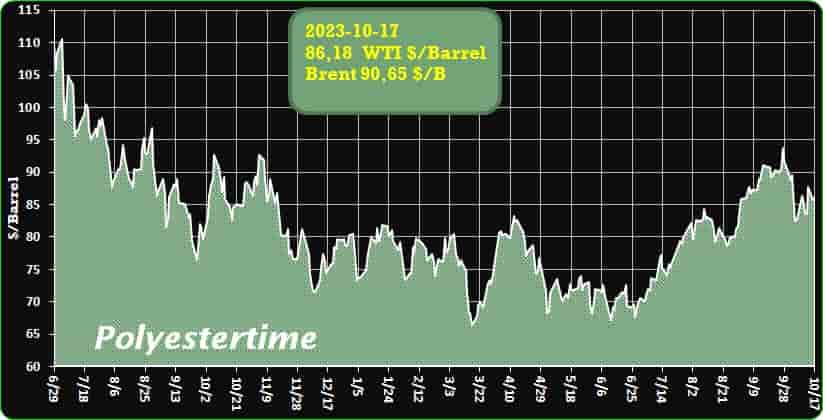
Crude Oil Prices Trend by Polyestertime
EFS-plastics investing $17M to enhance recycling capabilities
Improvements at the company’s Pennsylvania and Alberta locations are expected to come online over the next two years.
EFS-plastics, a Listowel, Ontario-based plastics reclaimer, says it intends to invest around $17 million in recycling technology upgrades at its plants in Hazelton, Pennsylvania, and Lethbridge, Alberta, with the aim of increasing its capacity to process films and rigid scrap.
According to Hendrik Dullinger, EFS-plastics U.S.’ vice president of business development, each facility will receive half of the funding. At the company’s Hazelton plant, which primarily focuses on recycling flexibles, the goal is to open up its capability to accept different grades. Pyrolysis Recycling
“We have a full film recycling line there already, but we want to open up our sales floor for a greater spec of materials,” Dullinger says.
The facility currently recycles Grade A commercial films, but, citing increased competition for those bales, Dullinger says upgrades to its sorting, washing and extrusion equipment will allow it to take on Grade B and C bales. In addition, the site also will start testing curbside collectible films. “We’re considering changing parts along the entire line to meet that,” Dullinger says.
Dullinger says new sorting equipment is expected to be operational in early 2024, while the third processing line is expected to be up and running by the summer.
The expansion in film processing capability is designed to meet potential requirements under extended producer responsibility (EPR) legislation and help brands meet circularity goals, Dullinger says. Pyrolysis Recycling
“Because we have a large footprint on the Canadian side of the border, this is what we have to focus on when it comes to curbside film, is the upcoming EPR legislation,” he says. “It requires the PROs [producer responsibility organizations] to look at films and flexibles and make sure they can become circular, so we’ll use Hazelton as a test facility as well to see how well it can do on curbside.
“But also in the U.S., if you look at some of the brands, brand commitments are a little weak at this point, but we still believe in the long-term,” he adds. “Brands will have to take action. We know that they’re increasingly looking at flexibles, so there will be a push eventually to take more of the residential film materials.”
The 70,000-square-foot plant in Lethbridge, which was added in 2022 and has primarily served as a secondary sorting facility feeding the company’s Listowel operation, will add washing and extrusion equipment. Pyrolysis Recycling
The facility processes Nos. 1-7 mixed rigid plastic bales sourced from material recovery facilities (MRFs) in the western U.S. and Canada.
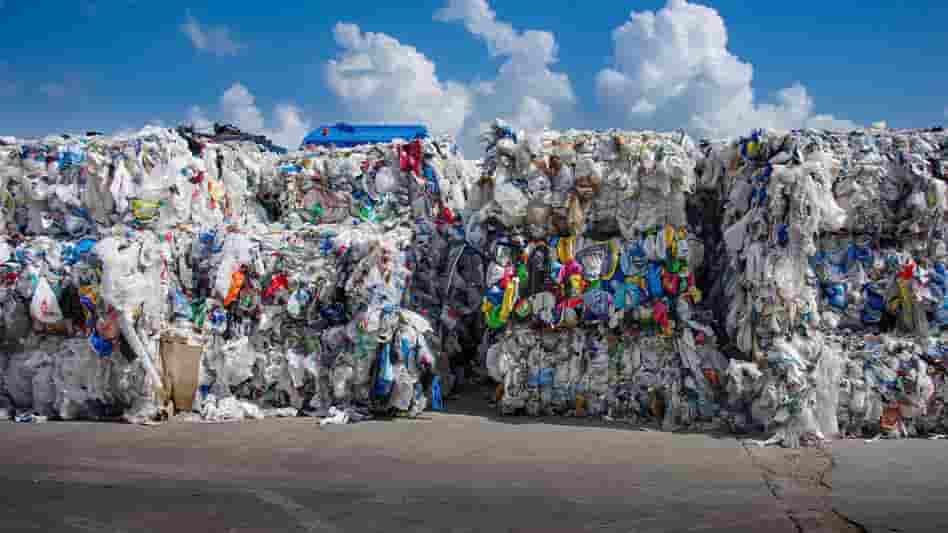
Climate crisis: Coca-Cola trial to make bottle tops from CO2 emissions
Coca-Cola has unveiled plans to make its bottle tops from carbon dioxide taken out of the atmosphere.
The firm – one of the world’s biggest users of plastic – is funding a three-year trial at Swansea University as part of the company’s target of net zero by 2040.
Much of its current plastic packaging is made cheaply, from fossil fuels.
But it aims to “capture” CO2 from the air, or from factory emissions, to produce a key ingredient for plastics. Pyrolysis Recycling
“The plastic we make today releases a lot of carbon dioxide into the environment,” said the project’s principle investigator, Professor Enrico Andreoli.
“Our starting material is carbon dioxide,” he said, “so we entirely de-fossilise the process and make plastic free from fossil fuels and fossil carbon.”
Plastic free from fossil fuels
Prof Andreoli, an industrial chemist, said the “magic happens” in a small black electrode where an electric charge passes through a mixture of CO2 and water, producing ethylene, a key ingredient in the flexible type of plastic used in bottle tops.
“We want to prove the technology in the laboratory works,” he said, explaining how “success” would suggest ways to scale up the process.
Coca-Cola says it will have to make “radical bets” on new technologies to try to reach its net zero by 2040 goal Pyrolysis Recycling
Coca-Cola’s goal is to use “captured” CO2 as a resource, taking it either from the air near its factories or directly from its own smoke stacks.
Ethylene is currently made as cheap by-product of refining petrochemicals, with fossil fuels heated to more than 800C (1472F), “cracking” off the molecules needed to make plastic.
Reducing carbon footprint
The process produced more than 260 million tonnes of CO2 emissions in 2020, or nearly 1% of the world’s total CO2 emissions, according to the climate tracking group the Global Carbon Project.
Craig Twyford, director of Coca-Cola’s venturing division for Europe and the Pacific, said the company’s promise for a 30% reduction in its carbon footprint by 2030 will mostly come from using more recycled plastics.
“From 2030 to 2040 we need to start making the more radical bets… looking at lots of different technologies. Pyrolysis Recycling
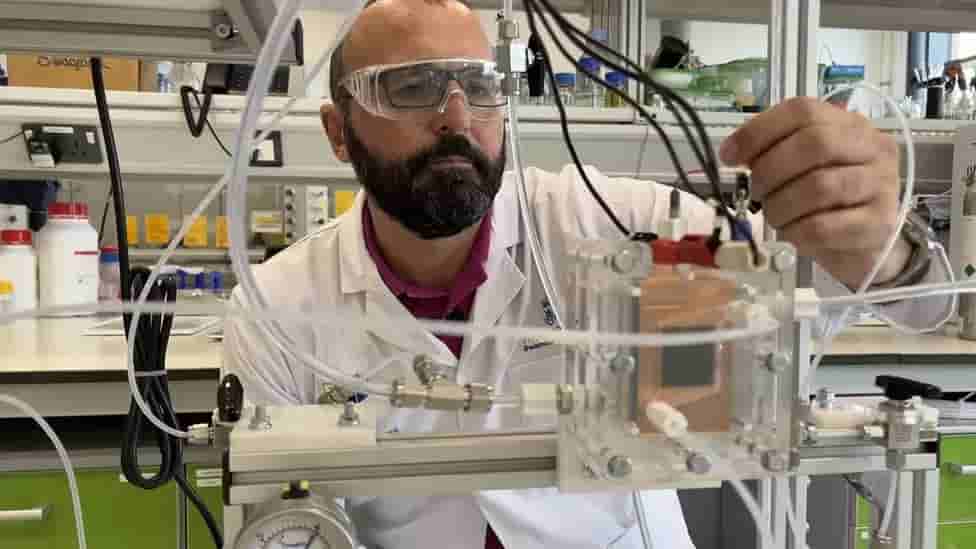
Pyrolysis-based Recycling Has Significant Environmental Benefits, Study Shows
New plastic made with just 5% pyrolysis oil produces up to 23% fewer greenhouse-gas emissions than crude-oil derived polymer, according to US Department of Energy research.
Pyrolysis-based advanced recycling can reduce greenhouse-gas (GHG) emissions and increase US recycling rates, according to a peer-reviewed life-cycle study published in the November 2023 issue of Journal of Cleaner Production.
The research conducted by the US Department of Energy’s Argonne National Laboratory reportedly is the first to look at the full cycle of post-use plastic from recycling to its integration in new plastic products at multiple facilities.
The study collected operating data from 2017 to 2021 at eight companies that use pyrolysis oil production processes. The oil replaces a portion of fossil fuel ingredients in the manufacture of ethylene and propylene. Pyrolysis Recycling
In this study, the new plastics made with the pyrolysis oil were low-density (LD) and high-density (HD) polyethylene (PE). When new plastic was made with just 5% pyrolysis oil, GHG emissions were reduced by as much as 23% compared with crude-oil derived LDPE and HDPE, according to the study. When current end-of-life practices for plastics in the United States, such as incineration, are factored in, there is a further 40% to 50% reduction in GHG emissions, the study found. In the European Union, where more post-use plastics are incinerated, the reduction may be as much as 131%. Other beneficial environmental outcomes include a 65% to 70% reduction in fossil energy use; up to 55% less water use; and a 116% to 118% reduction in solid waste.
Pyrolysis-based advanced recycling can reduce greenhouse-gas (GHG) emissions and increase US recycling rates, according to a peer-reviewed life-cycle study published in the November 2023 issue of Journal of Cleaner Production.
The research conducted by the US Department of Energy’s Argonne National Laboratory reportedly is the first to look at the full cycle of post-use plastic from recycling to its integration in new plastic products at multiple facilities. The study collected operating data from 2017 to 2021 at eight companies that use pyrolysis oil production processes. The oil replaces a portion of fossil fuel ingredients in the manufacture of ethylene and propylene.
In this study, the new plastics made with the pyrolysis oil were low-density (LD) and high-density (HD) polyethylene (PE). Pyrolysis Recycling
When new plastic was made with just 5% pyrolysis oil, GHG emissions were reduced by as much as 23% compared with crude-oil derived LDPE and HDPE, according to the study. When current end-of-life practices for plastics in the United States, such as incineration, are factored in, there is a further 40% to 50% reduction in GHG emissions, the study found. In the European Union, where more post-use plastics are incinerated, the reduction may be as much as 131%. Other beneficial environmental outcomes include a 65% to 70% reduction in fossil energy use; up to 55% less water use; and a 116% to 118% reduction in solid waste.
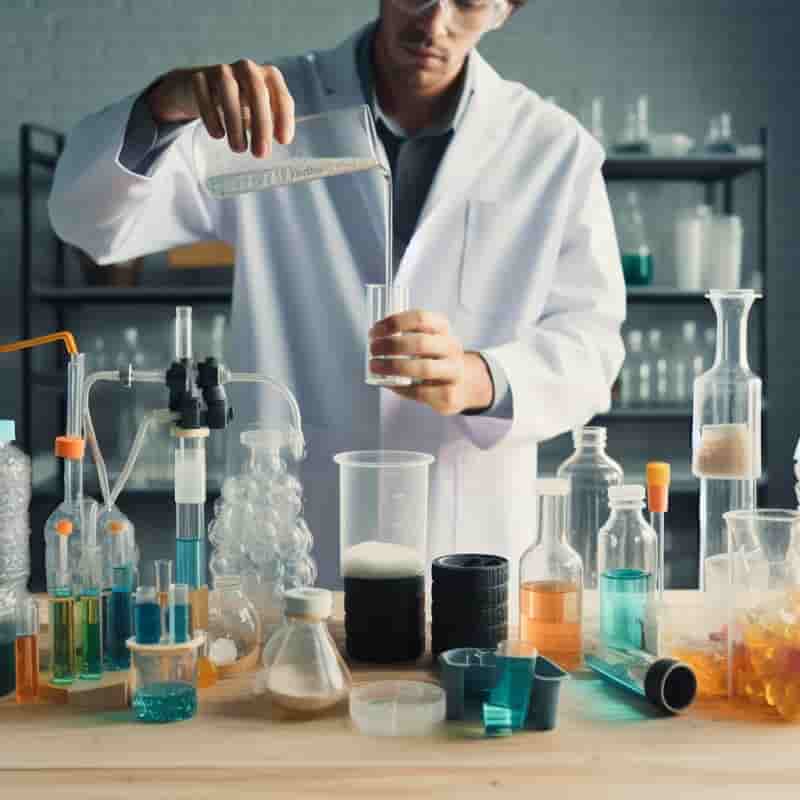
How to solve the common processing pain points of color masterbatches & filler masterbatches
Color is one of the most expressive elements, the most sensitive form element that can cause our common aesthetic pleasure. Color masterbatches as a medium for color, are widely used in various plastic products which are closely related to our daily life, adding colorful colors to our life. In addition, in plastic products, filler masterbatch also plays an important role in reducing the cost of products, improve production efficiency, enhance the rigidity of products and other aspects play an indispensable role.
Common Processing Pain Points of Color masterbatches & Filler Masterbatches:
Color masterbatch is a new type of special colorant for polymer materials. In order to make the pigment evenly dispersed in the masterbatch and no longer coagulate, enhance the weather resistance of the pigment, improve the dispersibility and coloring power of the pigment, it is often necessary to add dispersant in the process. Pyrolysis Recycling
Filler masterbatch is composed of carrier resin, filler and various additives. In the production process of filler masterbatch, in order to improve the processing fluidity of the masterbatch and promote the uniform dispersion of the masterbatch in the matrix resin, dispersants are also used.
However, in the actual production process many dispersants are difficult to solve the following problems, thus causing the production cost of color masterbatches & filler masterbatches to increase:
- Color powder agglomeration, filler agglomeration, thus affecting the final plastic products, such as products of different shades of color, the formation of many white hard particles or “clouds” on the products; Pyrolysis Recycling
- The accumulation of material in the mouth mold due to poor dispersion during the production of color masterbatches & filler masterbatches;
- Insufficient coloring and color fastness of color masterbatches.
SILIKE Silicone powder S201 is a powder processing aid containing ultra-high molecular weight polysiloxanes dispersed in silica, specially developed for masterbatches, polyolefin/filler masterbatches and other masterbatches, which can greatly improve the processing properties, surface properties and dispersion of fillers in the plastics system.
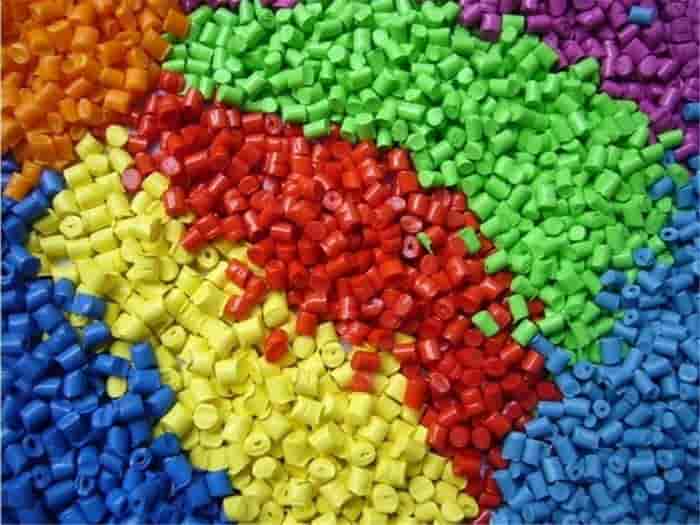
Birla Carbon Acquires Nanocyl to Drive Growth In Battery Materials for Lithium Ion Batteries
- Expanding material portfolio for key markets
- Establish leadership position in material critical to LiB performance
- Leveraging innovation to drive growth beyond Carbon Black
Birla Carbon, one of the leading manufacturers and suppliers of high-quality carbon solutions, completed the acquisition of Nanocyl SA, a worldwide leader in multi-wall carbon nanotubes (MWCNT’s) based in Sambreville, Belgium. The acquisition expands Birla Carbon’s presence in the Energy Systems market, creating a leadership position in material critical to Lithium Ion battery performance along with other conductive applications. Pyrolysis Recycling
Speaking about the acquisition, Dr. Santrupt Misra, Group Director, Birla Carbon; Director, Chemicals & Director, Group H.R., Aditya Birla Group, said, “Birla Carbon has been nurturing a number of innovation opportunities in its effort to realize its multi-prong sustainability agenda. The acquisition of Nanocyl is a clear step towards executing its strategy in that direction. We hope that this partnership will enable Birla Carbon to be a significant player in the emerging energy systems space. He further added, “Aditya Birla Group has been concentrating on investing in sustainability and circularity-driven initiatives led by innovation in order to be future-ready. The same is in line with our Purpose: to enrich lives by building dynamic and responsible Businesses that “inspire” trust.”
Sharing his thoughts on the acquisition, John Loudermilk, President and Chief Executive Officer, Birla Carbon, said, “We are thrilled to welcome Nanocyl into the Birla Carbon family. Pyrolysis Recycling
Laurent and his experienced team have been pioneers in the field of carbon nanotubes that provide unique performance characteristics for a wide range of applications, most notably energy systems such as lithium-ion batteries.”
He further shared, “Birla Carbon’s commitment to driving growth through innovation in sustainability aligns well with the potential for MWCNTs to enable the electrification of the transportation industry, deliver enormous environmental benefits, and prevent climate change. We are committed to partnering with our growing family of customers to create unprecedented value with the expanded carbon portfolio of products and technologies.”
Laurent Kosbach, Chief Executive Officer, Nanocyl, stated, “We are proud of our journey to develop and commercialize MWCNT’s successfully over the past 20 years as an entrepreneurial start-up, with the support of our current partners and investors. However, with growing needs for our products, the time has come to join a Global industry leader in order to maximize the synergies and the potential of these materials across many end uses.” Pyrolysis Recycling
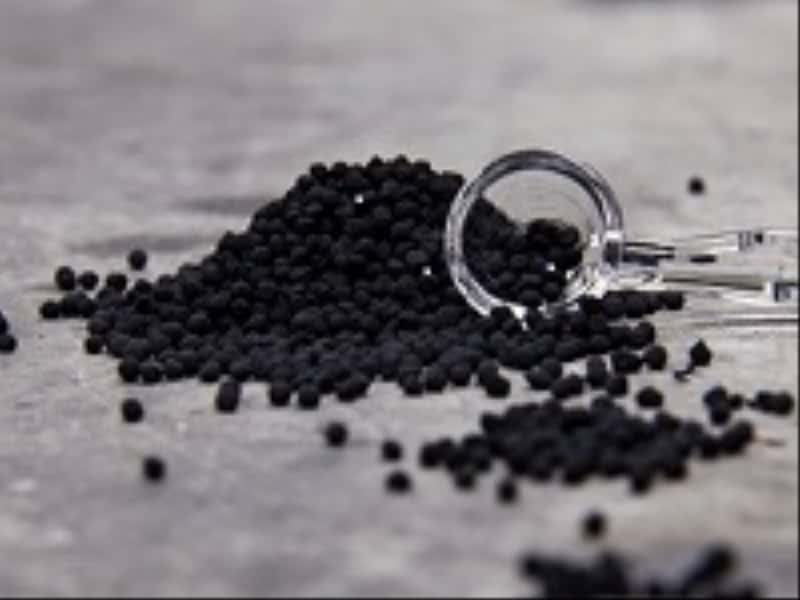
Closing the bottle cap loop: Greenpath and TOMRA pioneer mechanical sorting solution for separating polyolefins by polymer type and colour…
California-based full-service recycler, processor and manufacturer, Greenpath Enterprises, has partnered with TOMRA Recycling Sorting to install and optimise a plastic flake sorting production line designed to identify and separate mixed polyolefin caps from beverage bottles.
Operating for more than 25 years, the vertically integrated Greenpath accepts a wide range of materials, and the infeed stream is somewhat inconsistent. Greenpath creates value being a one-stop solution by accepting mixed infeed loads with variable supply streams and producing consistent, quality products.
In terms of post-consumer polyolefins – low-density polyethylene (LDPE), high-density polyethylene (HDPE) and polypropylene (PP) – Greenpath accepts film, rigid plastics and bottle caps. Pyrolysis Recycling
“Polypropylene and polyethylene (PE) are together the most abundant plastic family on earth, but the mixed polyolefin market is limited for valuable applications,” comments Eric Olsson, area segment manager, plastics for TOMRA.
PE and PP have very close density characteristics and are challenging to separate. So, mixed polyolefins are primarily downcycled into more forgiving applications that allow for more contamination.
The quest for cap to cap
A more mature PET recycling infrastructure has led to brand owners incorporating up to 100% post-consumer recycled content (PCR) material in their bottles. As regulations tighten to increase the percentage of recycled content, the next logical container component to address is the cap. “We are at the genesis of creating a sorting system for caps that is similar to what is more common today for bottles. Following Greenpath’s approach, the industry can move toward a 100% PCR by weight package using only a mechanical sortation,” says Olsson. Pyrolysis Recycling
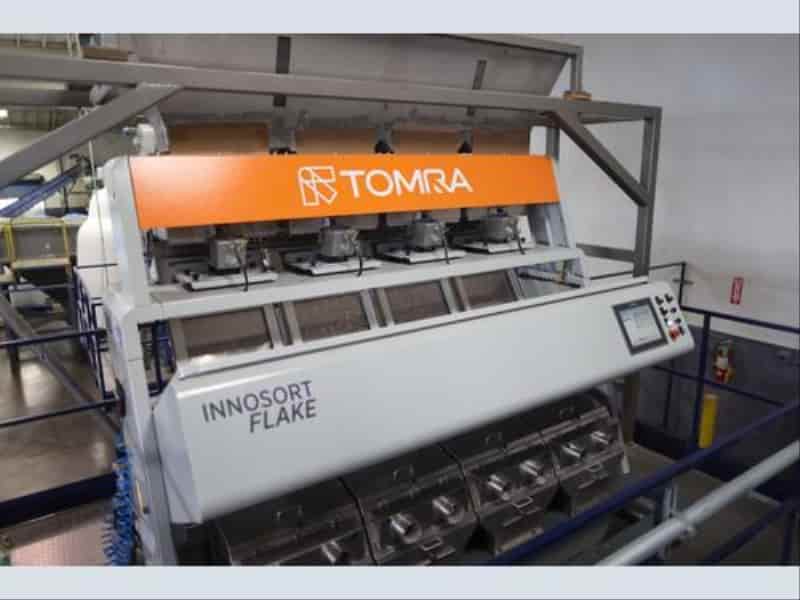
Pyrolysis Recycling
